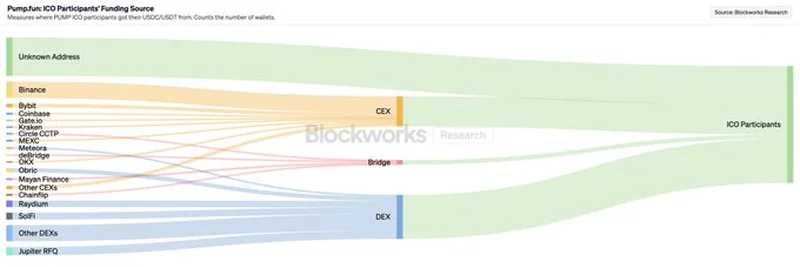Hey there, crypto enthusiasts! If you’ve been keeping an eye on the latest trends in the meme coin world, you’ve probably heard about the Pump.fun ICO. Recently, a fascinating thread on X by Sharples broke down where the participants of this ICO got their USDC and USDT from. Let’s dive into this analysis and uncover the juicy details—perfect for anyone looking to understand the evolving landscape of meme tokens and blockchain funding!
The Breakdown: Where Did the Funds Come From?
The thread includes a stunning visualization from Blockworks Research, showing the funding sources of Pump.fun ICO participants. Here’s what we learned:
- DEX (Decentralized Exchanges): About one-third of participants sourced their stablecoins from DEXs. This route is popular among those who prefer a decentralized approach, avoiding middlemen. Platforms like Jupiter RFQ and other DEXs played a big role here.
- CEX (Centralized Exchanges): Another third came from CEXs, with big names like Binance, Bybit, Coinbase, and Gate.io leading the pack. Binance, in particular, stood out as a major funnel for ICO funds.
- Bridges: Less than 400 participants used bridges, making this the least common method. Bridges connect different blockchain networks, but it seems most opted for simpler routes.
The chart also highlights an "Unknown Address" category, which is significant due to some users employing multiple addresses. This strategy can help diversify investments or obscure transaction trails—something worth watching in the crypto space!
A Closer Look at Multi-Address Strategies
One example really caught our attention. A single account (with the address 88888FAoqY6JdSvz7fk1FPd6qjPTcCMGcS64GbwonLoE) withdrew $200,000 from CEXs—$190,000 from Bybit and $10,000 from Binance. This account then funded 500 other addresses, each of which invested $400 in the Pump.fun ICO. That’s a total of $200,000 spread across 500 KYC’d accounts! This move suggests a coordinated effort, possibly to maximize participation or meet regulatory requirements.
The second image in the thread provides a detailed table of these transactions, showing amounts and values in USDC. It’s a goldmine for anyone analyzing how large players navigate ICOs.
What Does This Mean for the Meme Coin Market?
This data offers a glimpse into the strategies shaping the meme coin ecosystem, especially on the Solana blockchain, where Pump.fun thrives. The split between DEX and CEX usage shows a community divided between decentralization enthusiasts and those who trust centralized platforms. Meanwhile, the multi-address tactic hints at evolving playbooks—perhaps to dodge scrutiny or optimize returns.
Community reactions on X were mixed. Some, like odbtc.sol, pointed out the 500 KYC accounts, while others, like SolStrat, praised Binance’s dominance. Questions also arose about whether DEX users were existing PUMP holders or new investors—something future analyses might clarify.
Why This Matters for Blockchain Practitioners
For those in the blockchain space, this thread is a treasure trove. It highlights the importance of tracking funding flows, understanding exchange roles, and spotting multi-address patterns. Whether you’re a developer, investor, or enthusiast, keeping up with these trends can give you an edge in the fast-moving world of memecoins.
At Meme Insider, we’re committed to helping you stay ahead. Bookmark this page and check back for more insights into the wild world of meme tokens. Got questions or thoughts? Drop them in the comments—we’d love to hear from you!


